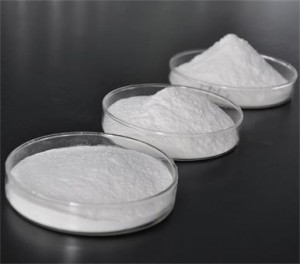Requirements for CMC In Food Applications
1.1 Substitution Uniformity of CMC
In general, the degree of substitution for CMC of food grade and toothpaste grade is 0.70-1.00. As we all know, the CMC products with good substitution uniformity are of good quality, specifically reflected in the good fluidity of product appearance, high transparency of aqueous solution, then in the application good substitution uniformity, smooth and delicate paste of the toothpaste prepared, and good water retention; in the applications of dairy products, manifested with delicate texture of milk, good flavor and taste, long shelf life, etc. The CMC of lower degree of substitution abroad (such as D.S=0.65~0.8) is better than that of higher degree of substitution at home (D.S: 0.85), that is, the uniformity of the latter is superior to that of the former. The reason is that the foreign process equipment is more advanced and the technological process is more reasonable. (Our company (Sidley Chemical Co.,LTD)has now imported some key equipment, adopted internationally advanced technological process, and fundamentally improved product quality.)
1.2 Significance of the Molecular Weight Distribution of CMC
CMC is a molecular compound. When D.S=1.0, the single molecular weight is equal to 242. The degree of polymerization determines the molecular weight, and the most intuitive performance in the physical properties is the viscosity. And whether the molecular weight distribution of product is uniform is manifested in the application as the stability of end product, rheology of solution, and film-forming property, etc.
Since 1999, the domestic studies have begun to investigate the molecular weight distribution of CMC and its significance, and fount that the molecular weight distribution may have the following significance:
The molecular weight of CMC is closely linked to many physical characteristics of CMC, especially the rheology of CMC solution. By studying the molecular weight distribution of CMC and characteristics of its solution, the setting of production process, and the rheological characteristics and stability requirements in the application become more controllable.
(1) The cotton pulp has a narrower molecular weight distribution than the wood pulp with the same average degree of polymerization (DP), i.e., the dispersion of the molecular weight of wood pulp is greater than that of cotton pulp. In the system of CMC solution, the impact of polymer chain length on the viscosity is more obvious, while the levels of degree of substitution and the arrangement of substituents have a greater impact on rheology, thickening property and solubility. This characteristic can be used to select the raw materials of different characteristics for the production of the products with different physical characteristics.
(2) For CMC with the same average molecular weight, the one with wide molecular weight distribution (i.e., larger dispersion of molecular weight) has better fluidity than that with narrow distribution, and under shear force, the molecular chain is easy for orientation. Using this feature, for the CMC that needs pseudoplastic property, the oriented control can be implemented. It should be particularly pointed out that when the substituent groups are unevenly distributed on the macromolecular chains, the obvious thixotropic property can be shown, but breakage of molecular chain may occur, making the stability of CMC under certain conditions somewhat reduced.
(3) For CMC with uniform distribution of substituents and narrow molecular weight distribution, its solution has good stability (salt and acid resistance).
1.3 Stability of CMC
For food (such as liquid dairy products and fruit drinks), CMC is mainly used as a thickener and stabilizer. When CMC is used as a thickener, it is mainly taken into consideration that the higher the viscosity is, the more economical it will be. However, in yogurt and juice, CMC with high viscosity is susceptible to degradation due to poor acid resistance, but will also affect the taste when adding much. Studies have found that:
(1) The stability of CMC is positively related to the substitution uniformity. The better the substitution uniformity is, the better the stability of CMC will be; the improved technology and an appropriate increase in the degree of substitution can improve the substitution uniformity of CMC.
(2) The stability of CMC is negatively related to the viscosity. The lower the viscosity is, the better the stability of CMC will be. Therefore, low viscosity CMC are often used in foreign food stabilizers.
The above results are obtained by multiple application experimental comparisons in the laboratory of our company, and have also been confirmed in the application feedback survey of domestic and foreign customers.

